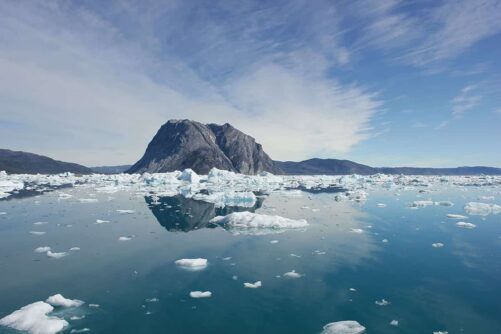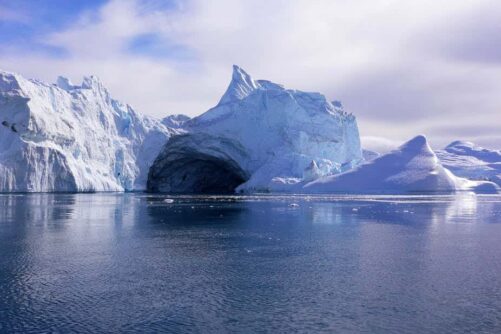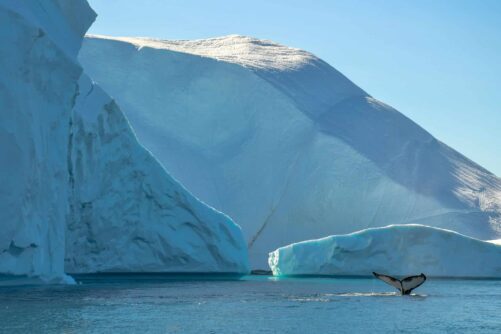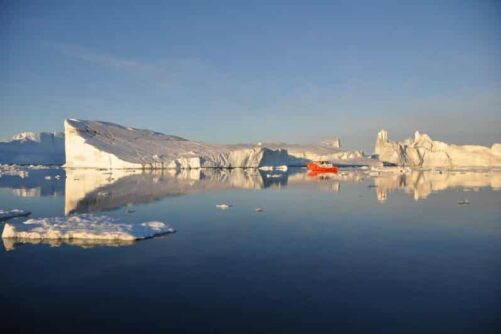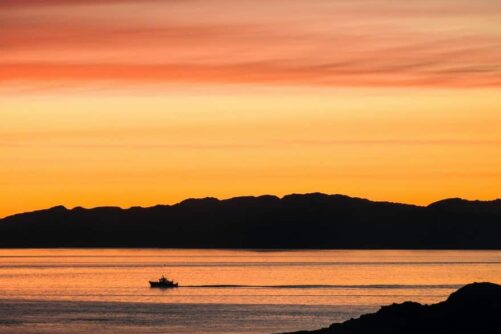

Polar expeditions in Greenland
Published: 08/06/2020
Reading time: 7 minutes
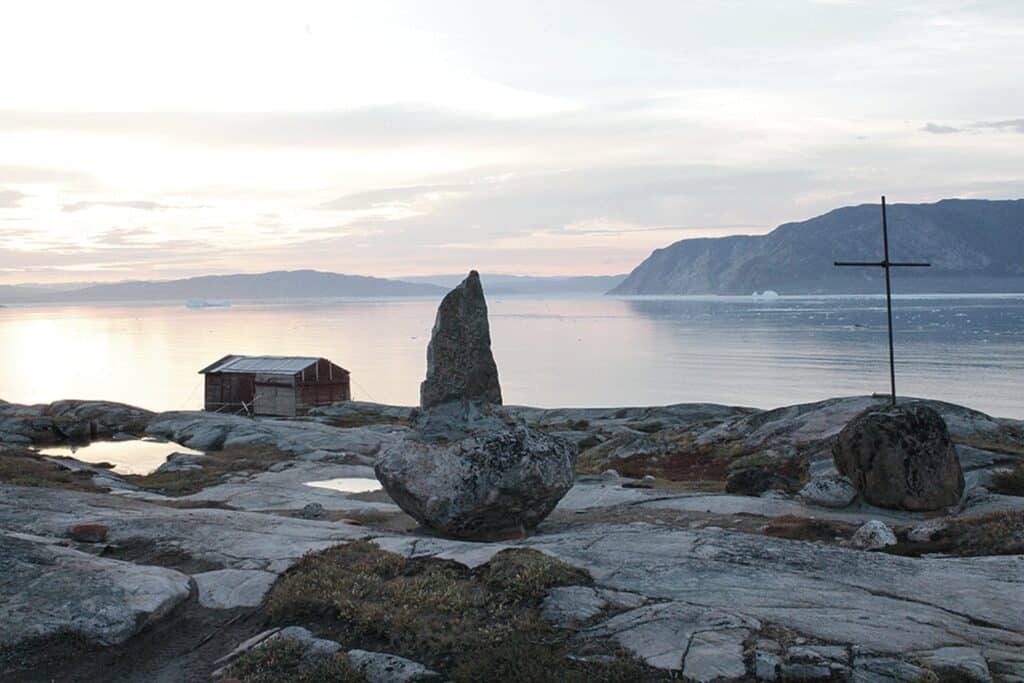
Evidence of French Polar expedition in the fells
In the fells close to the calving glacier, Eqip Sermia, in the north-eastern part of Disco Bay there are clear traces of the tracked vehicles that ethnologist Paul-Émile Victor used in his great polar expedition »Expéditions polaires françaises« in 1948-1953.

It gets more interesting as our little group of four tourists and one guide follow the signs. For hours we walk in the fells and on the ice sheet. Up and over moraine hills, fells and through valleys. On the way, we pass by the remains of the primitive wooden bridges that the members of the expedition built for the tracked vehicles.
At a former expedition camp there are steel wires and engines from an obsolete hoist and abandoned sleds which had been towed by the vehicles. In the middle of the fells there are cans, crates, caterpillar tracks and even mouth-blown bottles from the expedition. On the ice sheet we even find fabric remains from tents and bamboo sticks that have recently appeared in the melting ice. The sticks were used by the expedition 60 years ago to probe for glacier crevices, to measure snow depths and to mark routes.

Ice layers and movements
The abundance of evidence in the wilderness brings history to life. So we turn back time to the expedition’s first summer. On June 1st, 1948 the Norwegian freighter Force moored next to the glacier. On board were Paul-Emile Victor, 25 expedition members and 90 tons of equipment.
In order to transport the equipment on to the ice sheet, Paul-Émile Victor had come up with the wild idea of using eight American army surplus tracked vehicles – Weasels.
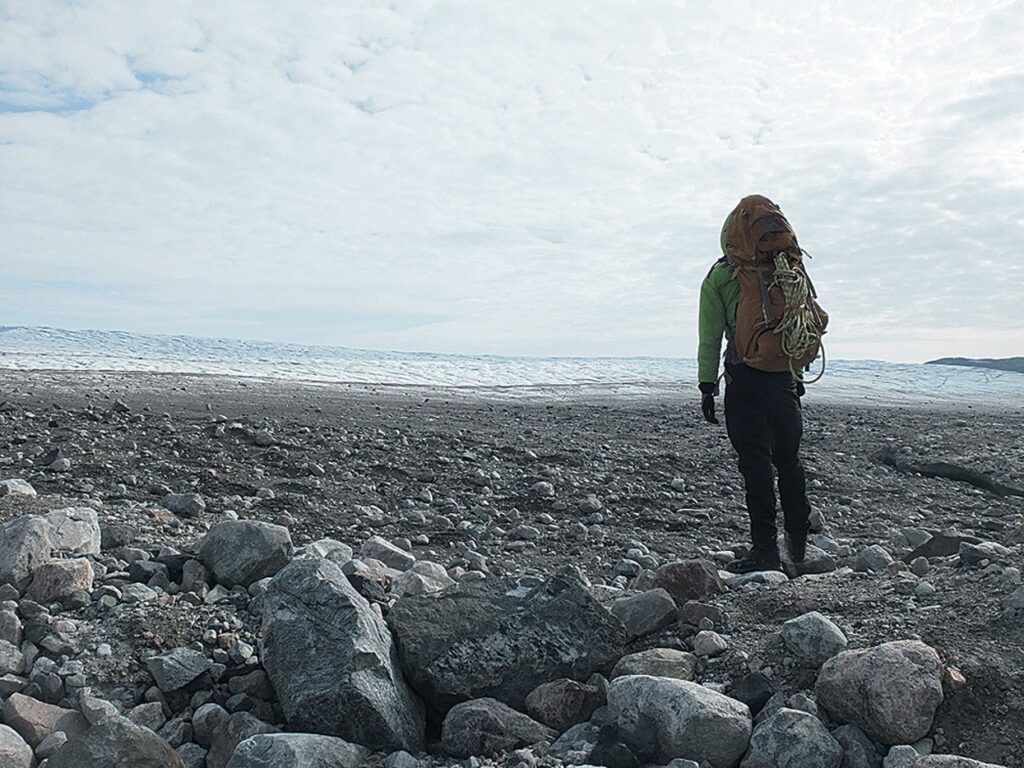
Glacier wave capsized boat
Several teams were sent out to search for a route to the ice. But it was not easy. The trail used by a former expedition in 1912 was not good enough for the tracked vehicles. However, one team discovered a new route which looked as if it would be passable after a few improvements. The route was later marked with cairns and cleared of rocks. Larger rocks were blasted out.
The 25 members of the expedition spent six days unloading the ship with the assistance of 15 Greenlanders. First, they had to build two jetties. The work was difficult because ice from the calving glacier a few kilometres away created such large waves that one of the boats capsized and one of the tracked vehicles sank.
Close to the ice sheet, the team met a bigger challenge, which Paul-Émile Victor wrote about in the periodical ARCTIC in 1949.
– The most difficult obstacle was a 500-foot cliff, but we had foreseen this and had brought with us a specially constructed cable-way for lifting supplies.

Mosquitoes and bad weather
The expedition established its second camp on a rocky slope. The first vehicle reached the ice sheet on July 9th, 1948 just nine days after the ship arrived. It took 15 convoys 46 days to bring the first expedition equipment up to the third camp on the ice sheet. The vehicles towed the sleds with equipment and 14 kilometres of pathway had to be laid and the equipment had to be lifted over the edge of the rock.
Other hardships to be endured by the members of the expedition that first summer included countless mosquitoes and bad weather. During the following four years, the glaciers and the ice were studied regularly, before Paul-Émile Victor left and continued his glaciological research in the Antarctic. Paul-Émile Victor’s wild project was a success and by using modern equipment he started a new era for the research of ice – glaciology.
The Frenchman retired many years later, perhaps weary of snow and ice. In any event, Paul-Émile Victor and his wife moved far away from snow and ice to the French Pacific island of Bora-Bora, where he died in 1995.
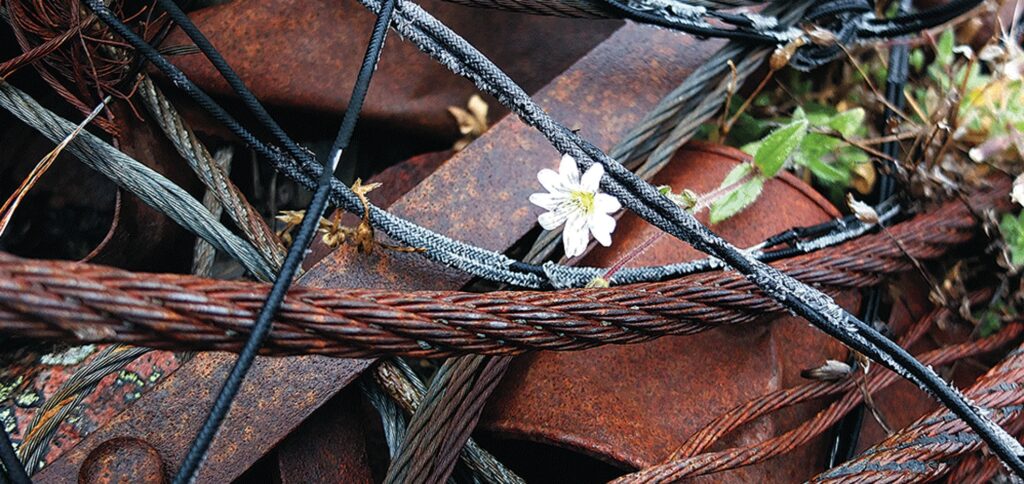
Denmark’s National Museum wants to preserve the traces
The area near Eqi is far from being the only place in Greenland where the landscape has indications that people have been there in recent times. Aircraft wrecks are frozen in the ice or lie in the fells. On the coast, there are abandoned settlements. In several areas there are the remains of expeditions and former military bases, industries, mining towns and weather stations, in addition to countless shipwrecks in the waters.
– In Greenland, there are many things from earlier times that have been left to decay, explains Jens Fog Jensen, senior project researcher at the National Museum in Denmark.
– It was only after the introduction of Home Rule in 1979 that expeditions or industries were required to clean up after themselves. It makes sense to preserve cultural and historical remains like those at Eqi, because they bring history to life. If there is local interest, they should be documented and the remains should be preserved so the story can be told.

Museum Curator Hans Lange from the Greenland National Museum explains that the remains do not come under Greenland’s museum legislation, since they come from abroad and are not originally Greenlandic. Georg Nyegaard, director at Greenland National Museum, adds that the remains are not currently preserved and there are no plans to raise a conservation order.
However, something is planned. In 2014, Qaasuitsup Municipality held a hearing about a plan to allow more tourist cabins in the area and to estab
lish a research and visitor centre. Per-haps this will bring the question of preserving the traces of Victor’s activities before the Committee for Greenland’s Heritage.

Paul-Émile Victor
28.6.1907 – 7.3.1995. French officer, ethnologist and polar explorer. He crossed the Greenland Ice Sheet in 1936. He wanted to use Expéditions Polaires Françaises (1948-53) to make meteorological and glaciological observations to determine whether the ice sheet was moving. He also acquired information regarding the ice sheet’s surface, density, temperature and its deeper layers. The drilled ice cores reached a depth of 151 metres. The density of the snow and ice and the temperatures at different depths were measured. Furthermore, seismic measurements of the depth of the ice sheet were made at several locations.
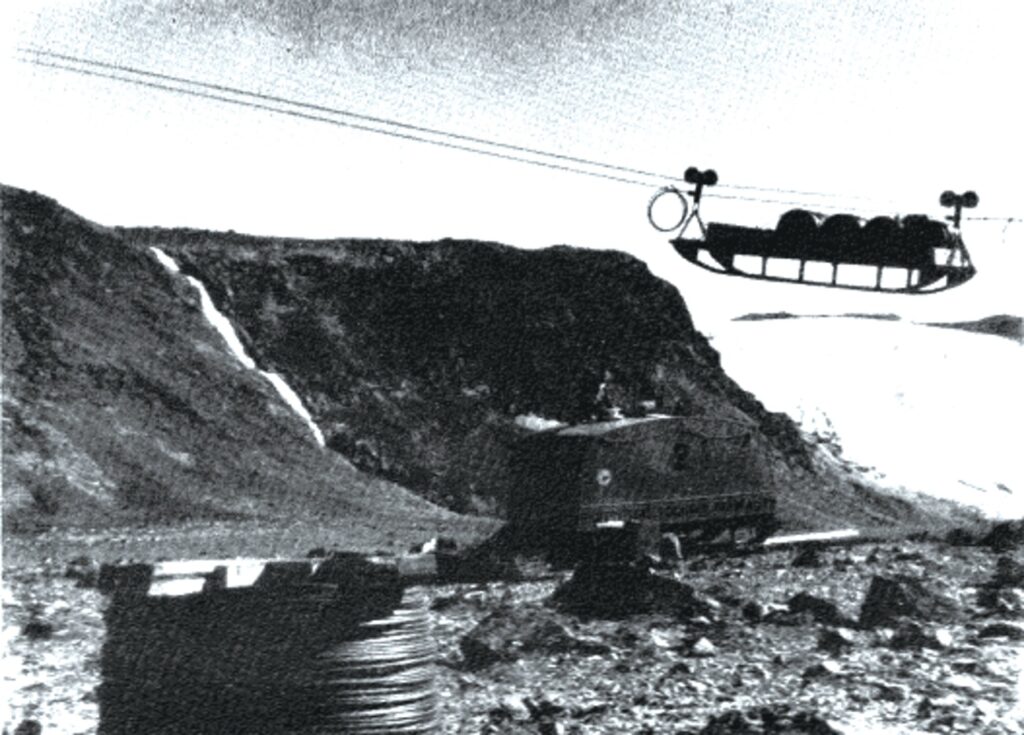
From the expedition equipment list, Summer 1948
- 7 tracked vehicles (Weasel M29C) – the eighth sank
- 14 aluminium sledges to be towed by the vehicles
- 3 trailers for laboratories
- 3657 metres of metal cable for the cable-way
- 3 winches
- 22.730 litres of gasoline
- Radio sets & radio equipment
- Food for 25 men for six months – based on 5,000 calories per man per day.
- Camping material and scientific instruments

Sources used in the article
The article »The French Expedition to Greenland, 1948« by Paul-Émile Victor published in »Arctic«, Journal of the Arctic Institute of North America, 1949, from which the historical pictures have been taken with permission. Geus.dk: Knowledge of Ilulissat, Arctic Institute, Wikipedia.dk, the article: »Overvintrings-stationer på Indlandsisen« (Winter stations on the Ice Sheet) by Jørgen Taagholt in the periodical Grønland 4/1998, denstoredanske.dk and Qaasuitsup Municipality: Public hearing Eqi, the open country, 2014.
Read more articles from Guide to Greenland
-
5.00(1)

Boat Transfer between Kulusuk and Tasiilaq | East Greenland
Tour startsKulusuk TasiilaqDuration1 hourFrom 2000 DKKSee more -
5.00(2)1 TO 6 PASSENGERS INCLUDED

Private Qoornoq Island Adventure | Nuuk
Tour startsNuukDuration4 hoursFrom 9000 DKKSee more -
New Tour!

Introduction to Stand-up Paddleboarding (SUP) | Nuuk | West Greenland
Tour startsNuukDuration2 hoursFrom 495 DKKSee more -
5.00(3)

Ghost Village Boat Cruise | Sisimiut | West Greenland
Tour startsSisimiutDuration3 hoursFrom 1040 DKKSee more -

Boat tour to Qarajaq Glacier | Uummannaq | North Greenland
Tour startsUummannaqDuration8 hoursFrom 4300 DKKSee more -

Whale Safari | Uummannaq | North Greenland
Tour startsUummannaqDuration4 hoursFrom 2900 DKKSee more -
4.75(8)

Closed boat Fjord Adventure | Nuuk
Tour startsNuukDuration2 hoursFrom 850 DKKSee more -
5.00(1)

Evening Kayaking Among Icebergs | Ilulissat | Disko Bay
Tour startsIlulissatDuration3 hoursFrom 1250 DKKSee more -

Nuuk Unveiled: 4-Day Through Greenland’s Capital & Nuuk Icefjord | West Greenland
Tour startsNuukDuration4 daysFrom 15700 DKKSee more -
5.00(1)

Ice Fishing | Kangerlussuaq | West Greenland
Tour startsKangerlussuaqDuration3 hoursFrom 650 DKKSee more -
1-10 people included

Boat charter | Open Boat | Qasigiannguit | Disko Bay
Tour startsQasigiannguitDuration2 hoursFrom 1600 DKKSee more -
5.00(1)

Afternoon Ilulissat Icefjord sailing | Ilulissat | Disko Bay
Tour startsIlulissatDuration2 hoursFrom 700 DKKSee more -
5.00(2)

Afternoon Whales & Ice | Ilulissat | Disko Bay
Tour startsIlulissatDuration2.5 hoursFrom 1700 DKKSee more -
Including flights to Greenland!

Highlights of Iceland & Ilulissat, West Greenland | 8 Days
Tour startsFrom IcelandDuration8 daysFrom 45400 DKKSee more -
4.33(3)New Tour!

Sail under the Midnight Sun | Nuuk
Tour startsNuukDuration2 hoursFrom 895 DKKSee more -
New Exiting Tour

Guided tour in Nuuk with UTV (Utility Terrain Vehicles) | Nuuk
Tour startsNuukDuration1.5 hoursFrom 1700 DKKSee more









